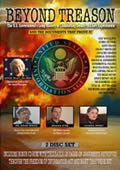Other
Yates
Articles:
Scuttling Bad Trade Agreements
OUR
MONEY SYSTEM
PART 2 of 3
By
Steven Yates
December 28, 2005
NewsWithViews.com
PART
2
The Biggest Swindle in History!
"If the American people ever allow private banks to control the issue of their currency, first by inflation, then by deflation, the banks and corporations that will grow up around them will deprive the people of all property until their children wake up homeless on the continent their Fathers conquered� I believe that banking institutions are more dangerous to our liberties than standing armies..." --Thomas Jefferson
The best account of the "banksters," as one might call them, is still G. Edward Griffin�s The Creature From Jekyll Island. Another useful item is downloadable from the Internet under the title I Want the World Plus 5%. Although Griffin�s main focus is the Federal Reserve system, he offers a compelling account of how the invention of fractional reserve banking empowered men whose subsequent influence usually went unmentioned in standard histories.
Early goldsmiths�the first bankers�stored precious metals for customers for a fee, and issued their customers a certificate. This made perfect sense; a certificate was much easier to carry around than a bag of gold. These certificates became the first currency. The bankers then noticed that few customers ever withdrew all their gold at once; actual withdrawals never exceeded around ten percent. They realized they could use certificates to issue loans as well as store coins. Griffin explains, "They said it was a pity for all that coin to just sit idle in their vaults. Why not lend it out and earn a profit which then could be split between themselves and their depositors? Put it to work, instead of merely gathering dust" (Creature, p. 165). It seemed safe to write certificates loaning out 80 or 90 percent, and charging the loan�s recipients� a fee: what became known as interest.
What had happened? The early bankers had discovered how to create "money" out of thin air. They became the first "banksters."
To make this clearer, let�s illustrate. Suppose we�re playing poker at Paul�s house, with Paul acting as banker. There are seven of us, and we�ve each given Paul $20 for 20 poker chips. So Paul�s cash box contains $140. Any of us can leave the game any time we want, and exchange each of our poker chips for a dollar. We�re enjoying the game, so no one leaves. The $140 remains in the box. The poker chips are functioning as backed currency for the purposes of the game. It is being held in escrow, one might say.
Now suppose Paul�s brother Peter shows up. He wants to borrow some money. Suppose Paul lends him $120 from the box. Strictly speaking, of course, Paul has no right to lend Peter that money. He ought to obtain an additional $120 to lend Peter, or use $120 of his own money. Paul cannot lend Peter $120 from the box and still consider the poker chips to retain their value as backed currency. If he loans Peter the $120 anyway, this leaves just $20 in the box. He has debauched the value of the poker chips, and also placed himself in an awkward position should both I and a companion wish to leave and both of us want back a total of more than $20. Paul would have to default on his contract, which was to keep our money safe for the duration of our participation in the game. A bank that defaults on its contract, fails. The banker is out of business.
Back to the early bankers. They stored, shall we say, $140 in gold from seven customers (all depositing $20 worth of gold) and issued $140 in the form of seven certificates, each stating their exact value: $20. The certificates might even say, will pay to bearer on demand, $20. Now would-be borrowers appear. A banker decides to "put [this money] to work." He issues additional $20 certificates for up to $120 of what he has in his vault, under the assumption that the original customers will not want their gold back all at once. Do the arithmetic, and we see that the banker has issued certificates totaling $260 (the original $140 plus $120 in loans). This despite his having just $140. He has created the other $120 out of thin air, ex nihilo, as God is supposed to have created the world. Only our banker is not God, and his certificates are no longer fully backed by one of God�s precious metals. They are being accepted and used as if they were, by borrowers who suspect nothing. They have become fractional money. The worth of the gold behind them is a fraction of their total face value. The actual worth of any particular certificate is therefore a fraction of its original worth. The supply of certificates in circulation has been artificially inflated.
The borrower believes, of course, that he can redeem his certificates for their full face value; he is being charged interest on their full face value! The banker collects the profit; he can extend the loan indefinitely, collecting more profit. This is fractional reserve banking, and if we understand fractional reserve banking, we can understand the basis for the greatest swindle in the history of Western civilization�and why the Founding Fathers empowered Congress (not bankers) to "coin money, and regulate the value thereof."
The bankers, of course, adopted the motto, "Tell no one." The process became a trade secret, beginning the cloak of secrecy that has surrounded international investment banking ever since. It didn�t always work. Banks did fail.
But if owners of large banks feel safe lending out and charging interest on more and more certificates, the fraction that represents the real value of the certificates shrinks until it approaches zero�in which case the certificates are completely off their original gold standard. As Griffin puts it (Creature, p. 169), "fractional money will always deteriorate into fiat money. It is but fiat money in transition." Fiat money is just unbacked paper currency, protected by legal tender laws compelling citizens to use it as real money and mandating severe penalties for anyone who doesn�t.
The temptation of fractional money is just the temptation of easy money: the lure of unearned wealth. Things began to get nasty when European bankers began loaning huge sums of fractional money to governments. The two started working together in the late 1600s, with a government granting a charter to a group of "monetary scientists" to start a bank and giving it a legal monopoly. The bank then created fractional money and loaned it to the government as needed. Thus was invented central banking. Central bankers could easily generate enough "revenue" to bankroll wars by manufacturing money for the government�s use�as much as it needs! The bankers not only got rich but enjoyed the government�s full protections. After all, the central bank must not under any circumstances be allowed to fail! Thus a central bank by definition operates outside the confines of a free market.
The most famous family of central bankers, of course, is the House of Rothschild, founded in Frankfort, Germany by Mayer Amschel Bauer who changed his last name to Rothschild, and whose five sons�Amschel, Salomon, Nathan, Kalmann (Karl), and Jacob (James)�because the first prominent internationalists. Each was placed in charge of a central bank in one of the five centers of influence: Amschel in Frankfort, Salomon in Vienna, Nathan in London, Karl in Naples, and James in Paris. Working closely together, they became the most powerful bloodline in 1800s Europe. M.A. Rothschild had said, "Give me control over a nation�s currency, and I care not who makes its laws." His sons worked closely together. Salomon wrote Nathan in 1815, "We are like the mechanism of a watch: every part is essential."
One cannot study the House of Rothschild without getting a whiff of sulfur. Rumors abounded that the Rothschilds were closet Satanists. Be this as it may, they manipulated kings and governments at will. Anyone who got out of line found himself in the midst of a spectacularly nasty war. The Rothschilds despised laissez-faire economics. They realized it implied absence of indebtedness to the banks. They did not want financial independence. They wanted the cattle (their view of us ordinary mortals) tied to wage slavery and subject to authoritarian regimes�bankrolled by their henchmen, of course.
It stands to reason they would hate America, and set about to bring her down. A book entitled The Coming Battle: The True History of Our National Debt, originally published around the last turn of the century and recently rescued from oblivion by Paul Walter, of the NewsWithViews.com commentary site, documents our government�s furious struggle to rein in power-hungry bankers throughout the 1800s. Yet with the rise of corporate empires like those of Morgan, Rockefeller and Carnegie (all recipients of Rothschild assistance), and the growing influence of "money power" on the federal government, the struggle was lost in 1913. The day before Woodrow Wilson signed the Federal Reserve Act, Congressman Charles A. Lindbergh Sr. (father of the famous aviator) told the House, "This Act establishes the most gigantic trust on earth. When the President signs this bill, the invisible government by the Money Power will be legalized." In this way 1913 is a pivotal year in U.S. history. That was the year the incipient shadow government controlled by the banking cartel assumed control over the American financial system and therefore over the U.S. economy. Keynesian economic theory would later rationalize this centralization and micromanagement. (It is worth noting in passing that 1913 was also the year the IRS was created.)
The swindle proceeded from there. The quick and dirty version goes something like this: the collusion between the cabal of "banksters" and the federal government began to saddle every man, woman and child with an albatross of debt, by building up a money system and an economy based on debt�fractional money borrowed from the banks, who�with the full protection of the federal government�have created money out of thin air. In Part One, we examined how we finally departed from the gold standard that once meant sound dollars. Now our total indebtedness cannot be paid off, even in principle. Were the national debt (which officially surpassed $8 trillion on Oct. 18) ever to be paid off, there would be no currency in circulation�hard as that is to believe! As crazy as it sounds, our entire money supply�the sum total of currency in circulation�exists because it was borrowed. The "banksters" collect the profits and sink them into their tax-exempt foundations. What Griffin calls the Mandrake Mechanism is the banking machinery that converts debt into fiat money. (See Creature, pp. 185-207.)
In this process lies the explanation why the Rothschilds and the Rockefellers are multibillionaires many times over, while you and I live from hand to mouth despite working two and maybe three jobs. It explains why people who once held down good-paying jobs are just as strapped for cash. It helps explain, in combination with the various ways of redistributing wealth we adopted when our society accepted the essential features of Fabian socialism, why the cost of living has gone into the stratosphere. The amount of fiat money in circulation has soared; our wages have not. Everybody knows how wages have "stagnated" since 1971, the year we went off the gold standard.
Again, an illustration is helpful. Suppose the federal government claims to need $1 billion for whatever purpose. Obviously it doesn�t have $1 billion, since politicians and bureaucrats produce nothing (with the possible exception of misery). The feds go to the "banksters" in the Federal Reserve. They agree to deliver the $1 billion in credit to the feds in exchange for the latters� agreement to pay it back with interest. Congress authorizes the Treasury Department to print $1 billion in U.S. Bonds, delivered to the "banksters." The Treasury Department prints $1 billion in bank notes, "bought" from the Federal Reserve (which pays only the printing costs!) and exchanged at full face value for the Bonds. The feds use the $1 billion for whatever they claimed to need it for. And they have indebted the people�that�s you and me�to the "banksters" for $1 billion more�plus interest!
Now replicate this process several thousand times.
You or I, of course, would be imprisoned if we did this. But it�s legal when the government and the "banksters" do it. This has been going on since 1913, and explains the $8 trillion national debt. In 1920, the national debt had jumped to $24 billion from around $1.15 billion (the debt when the Federal Reserve was being covertly planned at Jekyll Island). By 1968 it had risen to $347 billion. It reached $1 trillion right after Reagan went into office, and topped $2 trillion right around 1986. In 1992 it hit $4 trillion. It surmounted $7 trillion in January of 2004. Now it�s $8 trillion. In other words, we have amassed more debt in less than two years than was amassed during the first 200 years of this country�s history! And the process is accelerating!
The federal government has become a bloated Leviathan existing on borrowed money and borrowed time. It is difficult to know which major party is worse. The Democrats authorize policies based on a philosophy of tax-and-spend. They rip off the public directly. The Republicans authorize policies based on a philosophy of borrow-and-spend. They rip us off indirectly. Both parties are controlled by the "banksters," protected by their many shills in the mainstream media.
I submit that this money system has almost completely destroyed the foundations of this country. It has also destroyed the so-called American Dream�whatever hope any of us might once have had of "succeeding" working within the system, playing by its rules. (Genuine entrepreneurship is still possible, but extremely difficult.) Our money system may be the biggest swindle not just in U.S. history but the biggest swindle ever, especially as most of the public has no idea it has been swindled. While any of the seven poker players in our illustration above could leave the game any time they wanted, you and I can leave this larger "game" only by croaking! Even then, your kids will get stuck with the bill!
The plain truth is, for all the talk of an "economic boom" in the 1990s (it was an expansion of the amount of fiat money in circulation, so that loans were easy to obtain), and for all the talk about a "housing boom" in the present (again the result of credit spending, i.e., debt), this system is manifestly not sustainable. It must eventually crash and burn; it is not a matter of if, but when.
The "banksters," of course, are still keeping to that adage: "Tell no one." Their money long ago came to control academia via the endowment system, government schools via their control over education schools, money from tax-exempt foundations such as Carnegie and Rockefeller, unions such as the NEA and agencies such as the DOE (see Iserbyt�s tome referenced in Part One for details) as well as the mainstream media that controls the information that reaches the public. That is why people who write the way I have here are dismissed as "conspiracy kooks," as has been G. Edward Griffin despite his massive documentation from Federal Reserve materials themselves.
|
Subscribe to the NewsWithViews Daily News Alerts! |
President James A. Garfield said way back in 1881, "Whoever controls the volume of money in any country is absolute master of all industry and commerce." Not long after uttering those words, he was shot in a Washington railroad station and died two and a half months later.
� 2005 Steven Yates -
All Rights Reserved
Steven Yates, Ph.D., is the most published professional philosopher in South Carolina. He teaches as a lowly adjunct instructor of philosophy at University of South Carolina Upstate (occupational punishment for his utter lack of political correctness and for pursuing issues from the standpoint of adherence to Constitutionally limited government, personal moral responsibility guided by a Christian worldview, and the rule of law as opposed to arbitrary rule by politicians, judges, and unelected bureaucrats). Later this month he will be joining the faculty at Greenville Technical College in Greenville, S.C., also as an adjunct.
He is the author of Civil Wrongs: What Went Wrong With Affirmative Action (San Francisco: ICS Press, 1994) and Worldviews: Christian Theism vs. Modern Materialism (delayed, but due out this summer). He also works on manuscripts with names such as In Defense of Logic and Philosophical Questions as well as on a science fiction novel, Skywatcher�s World. His articles and reviews have appeared on LewRockwell.com as well as NewsWithViews.com and other websites. He has also published in academic journals including Inquiry, Metaphilosophy, American Catholic Philosophical Quarterly, Reason Papers, Public Affairs Quarterly, Journal of Libertarian Studies, Quarterly Journal of Austrian Economics and others. He recently held a year-long fellowship with the Ludwig von Mises Institute in Auburn, Ala., has appeared at conferences ranging from the American Philosophical Association to the South Carolina Society for Philosophy, and made numerous talk radio appearances. He spoke on �The Real Matrix and Sustainable Development� at the recent 6th Annual Freedom 21 National Conference in Reno, Nev. He lives in Greenville, South Carolina, where he also directs the Worldviews Project and is a member of the S.C. Chapter of Citizens Committee to Stop the FTAA.
His blog is at:
http://itshappeninghere.blogspot.com
E-Mail: freeyourmindinsc@yahoo.com.
Early goldsmiths�the first bankers�stored precious metals for customers for a fee, and issued their customers a certificate. This made perfect sense; a certificate was much easier to carry around than a bag of gold. These certificates became the first currency.













